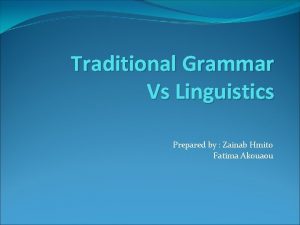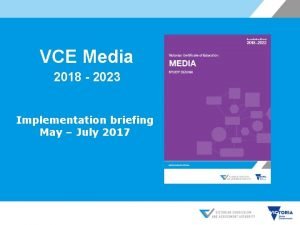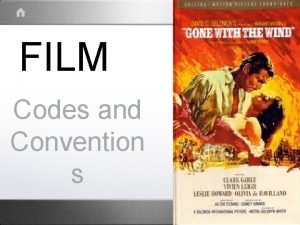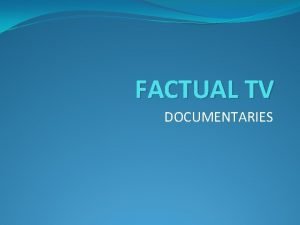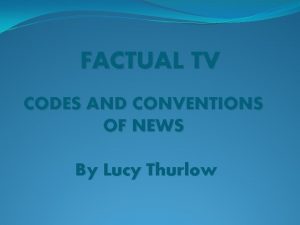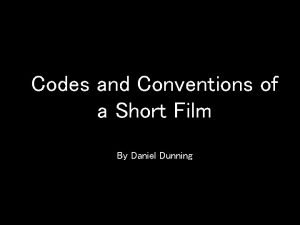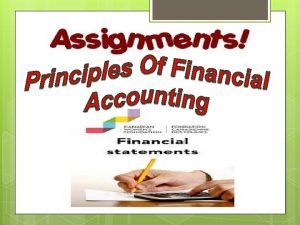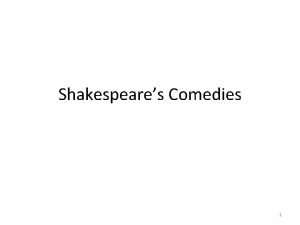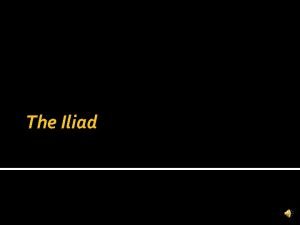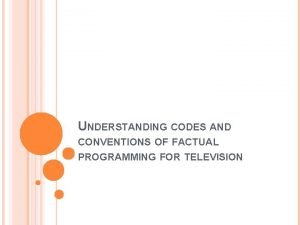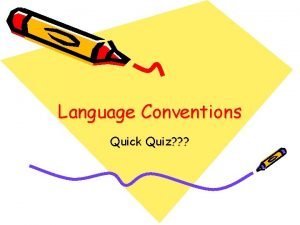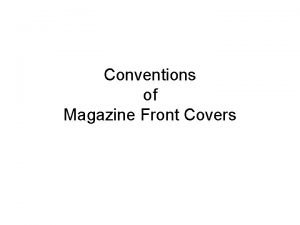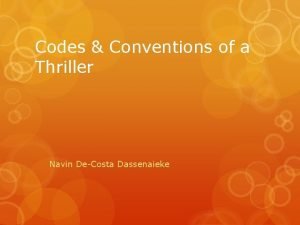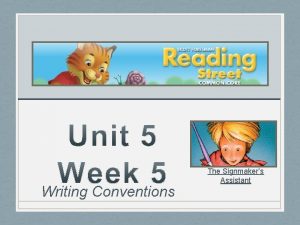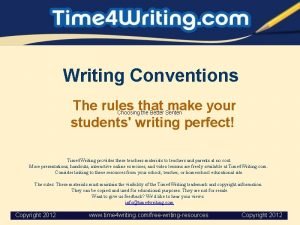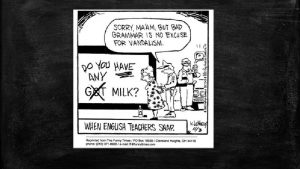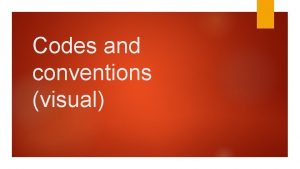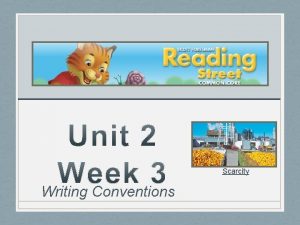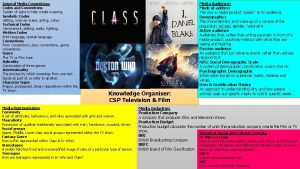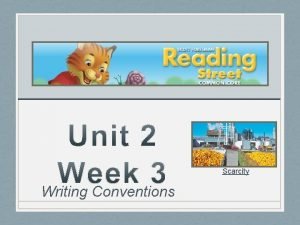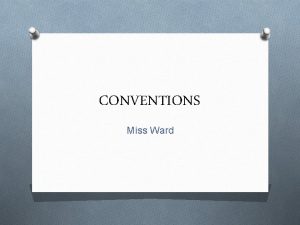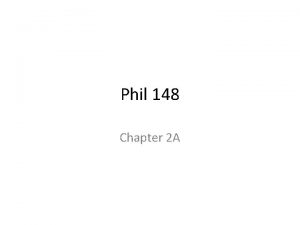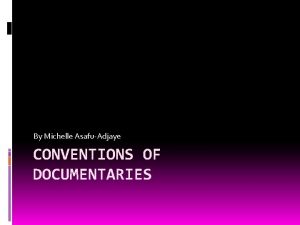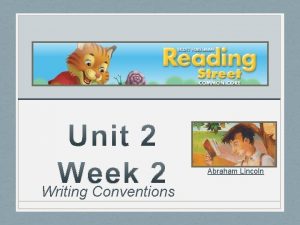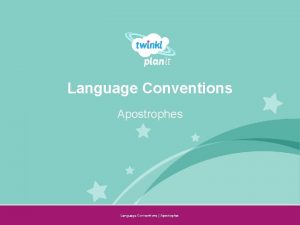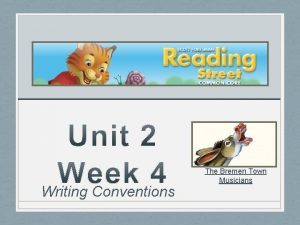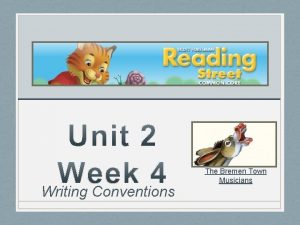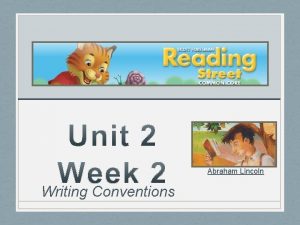Grammar and Conventions ELA 9 C 1 ELA





































- Slides: 37

Grammar and Conventions ELA 9 C 1, ELA 9 C 2

Sentence Structures There are four types of sentences: Simple sentences have only one independent clause. I want a puppy for Christmas.

Compound sentences are made from two or more simple sentences, joined either by a comma and conjunction or by a semicolon. They include two or more independent clauses. I want a puppy for Christmas, but my mother is allergic to dogs. I want a puppy for Christmas; my mother is allergic to dogs.

A complex sentence contains one independent clause and one or more dependent clauses. I want a puppy for Christmas because I have never owned a pet.

A compound-complex sentence contains two or more independent clauses and one or more dependent clauses. I want a puppy for Christmas because I have never owned a pet, but my mother is allergic to dogs.

*PRACTICE What type of sentence am I? 1. Mary pruned the bushes while Ben mowed the lawn. 2. Dolores and Ricki went canoeing with their friends after church on Sunday. 3. Three divers are trying out for a spot on the team, and there is only one dive remaining. 4. Since Paul ran faster than all of his classmates, he won the prize. 5. Never talk to strangers, and call 911 if you have an emergency.

Sentence Fragments A sentence fragment tries its best to be a sentence, but it just can’t make it. It’s missing something. Often, it’s missing a verb or part of a verb string: John working extra hard on his hook shot lately. Here, for instance, we’re missing an auxiliary — has been, in this case, probably — that would complete the verb string and the sentence.

Missing Subject It may also be missing a subject, as well as part of the verb. Spending hours every day after school working on her project. This time we’re missing a subject AND part of the verb. As it is, this is just a participle phrase. There is no subject in the sentence, and there is no helping verb to make a complete verb phrase.

Avoiding Sentence Fragments Sometimes a sentence fragment can give you a great deal of information, but it’s still not a complete sentence: After the coach encouraged him so much last year and he seemed to improve with each passing game. Here we have a subject-verb relationship — in fact, we have two of them — but the entire clause is subordinated by the dependent word after. We have no independent clause.

Avoiding Sentence Fragments Be alert for strings of prepositional phrases that never get around to establishing a subject-verb relationship: Immediately after the founding of the college and during those early years as the predominant educational institution in the American Midwest. Again, be careful of sentences which give their share of information but still don’t contain a subject and verb.

Avoiding Run-on Sentences The length of a sentence has nothing to do with whether or not a sentence is considered a run-on. An over-exuberant, run-off-at-the-mouth, 400 -word gorilla of a sentence can be structurally fine. A run-on sentence is one in which two clauses have been connected incorrectly. (If you’d like, click on the word “clauses” to review that concept. )

Avoiding Run-on Sentences Let’s think of an independent clause as an independently operated train headed west. . . getting connected to another train headed east. Nothing but grief will result from coupling these train clauses incorrectly! For example. . Some students think they can study for an important exam by “cramming” all night, they are probably wrong.

Avoiding Run-on Sentences Some students think they can study for an important exam by “cramming” all night, they are probably wrong. This is an example of the dreaded COMMA SPLICE! A comma splice connects two independent clauses with only a comma. There are several ways to fix a comma splice. .

Avoiding Run-on Sentences 1. We can insert a period and start a new sentence. Some students think they can study for an important exam by “cramming” all night. They are probably wrong. 2. We can insert a comma plus a coordinating conjunction. Some students think they can study for an important exam by “cramming” all night, but they are probably wrong. 3. We can use a semicolon. Some students think they can study for an important exam by “cramming” all night; they are probably wrong.

Avoiding Run-on Sentences There are three situations in which run-on sentences are apt to happen: 1. When a pronoun in the second clause refers to a noun in the first clause: The President’s popularity has plummeted, she apparently underestimated the opposition. 2. When a suggestion or directive occurs in the second clause: You will be responsible for this material on the final exam, study it thoroughly now. 3. When two clauses are connected by a transitional expression: Many people think protectionism can halt rising prices, however, the opposite is actually true.

Avoiding Run-on Sentences 1. The President’s popularity has plummeted, and she apparently underestimated the opposition. 2. You will be responsible for this material on the final exam. Study it thoroughly now. 3. Many people think protectionism can halt rising prices; however, the opposite is actually true.

Parallel Sentence Structure Parallel sentence structure means parts of a sentence with equal importance are expressed with equal emphasis. In other words, verbs match with verbs, adjectives with adjectives, prepositional phrases with prepositional phrases, and so on.

EXAMPLES Not Parallel: Janine likes to dance, sing, and even plays the flute. Parallel: Janine likes to dance, sing, and play the flute. Not Parallel: When I think the rain will never stop, the sun comes out, I hear the birds begin to sing, and the flowers raise their little heads. Parallel: When I think the rain will never stop, the sun comes out, the birds begin to sing, and the flowers raise their little heads.

Subject-Verb Agreement Grammar rules state that the subject of the sentence must agree with its corresponding verb. The subject is the word performing the action. In the examples below, each subject is underlined, and each verb is bolded. My older brothers play baseball in the park. The frog croaks in the pond every night.

S-V Agreement. . . The subject of a sentence does not necessarily have to appear before the verb. In questions and sentences with here and there, the verb usually comes before the subject: When is Dorothy coming to plant her flowers? There are four boys in my class.

S-V Agreement. . . When two or more singular nouns or pronouns are connected by or or nor, use a singular verb. The book or the pen is in the drawer. When a compound subject contains both a singular and a plural noun or pronoun joined by or or nor, the verb should agree with the part of the subject that is nearer the verb. Her friends or the girl runs every day.

S-V Agreement. . . Do not be misled by a phrase that comes between the subject and the verb. The verb agrees with the subject, not with a noun or pronoun in the phrase. l One of the boxes is open l The people who listen to that music are few.

*PRACTICE: fix each sentence below… 1. 2. 3. 4. 5. Mickey Mouse makes funny comments during his cartoons. Mrs. Nally and her friends plays cards during the night. There is five pencils on the floor. Louise and Rita is going to Disneyland. The woman with all the dogs walk down my street.

Shifts in Verb Tense It is important to choose ONE verb tense and use it throughout your writing. Non-parallel: Tiffany finishes her homework and will do the dishes. Parallel: Tiffany will finish her homework and will do the dishes.

Modifiers (3 types) 1 -Modifiers are phrases and clauses the help to clarify the meaning of a word. 2 -Misplaced modifiers alter a word or phrase ambiguously. Wrong: Two students competed against the school record diving in the swimming pool. Correct: Diving in the swimming pool, two students competed against the school record.

Modifiers. . . 3 -Dangling modifiers come at the beginning of a sentence but do not modify its subject. Wrong: Listening to hip hop music, her arms began to move with the rhythm. Correct: Listening to hip hop music, Latasha began to move her arms to the rhythm.

* PRACTICE Correct the following. . . (rewrite it correctly on your paper!) 1. While fishing in the river, a large piece of driftwood floated by. 2. One of our scouts sighted a tank through his night vision glasses that he could not identify. 3. Working at this beach side resort for many months, sunstroke affects many lifeguards.

Capitalization Capitalize the first word of a sentence. l Capitalize the first word of a direct quotation that is a complete sentence, even if it is within another sentence: Mr. White said, “Be on time!” l Capitalize the names of specific person, places, things, or ideas, including races and nationalities, street and road names, specific titles of courses (Algebra I, not math) l

Commas Rule 1=Commas separate independent clauses only when they are joined by a coordinating conjunction (for, and, nor, but, or, yet, so). Example: Jesse ran to the gas station, but he forgot his money.

Commas. . . Rule 2=Commas usually follow an introductory word, phrase, clause, or expression: Examples: When I drive home from school, I go right by your house. After church on Wednesday night, we usually go to Ci. Ci’s pizza.

Commas. . . Rule 3=Commas are usually used to separate items in a series of three or more words, clauses, or phrases. Example: Tacos, tamales, and fajitas are my favorite foods.

Commas. . . Rule 4=Commas are used to set off an appositive phrase: Mrs. Jones, my favorite teacher of all time, works at my old elementary school.

Commas. . . Rule 5=Commas are used before and after quotations, unless the quotation ends the sentence. Example: “Go at once, ” Gene commanded, “and see what is causing the commotion!” Mom said, “It’s time to wake up. ”

Quotation Marks Use quotation marks to signify a direct quotation. *Periods and commas always go inside the quotation marks. *Exclamation points and question marks go inside ONLY if they’re part of the quoted material. Example: “Here we go again, ” Keisha said. What’s the matter? ” asked Lisa.

Quotation Marks. . . Use quotation marks to signify a short work of literature (such as a poem or short story) or a speech. Underline larger works such as books and plays. Martin Luther King’s speech, “I Have a Dream, ” had a wide impact. Have you read “The Most Dangerous Game”?

Colons Use a colon to introduce a list, series, quotation, or formal statement. At some time in your life, you will ask the question: Why do I exist? We brought everything needed for a camping trip: food, water, tents, blankets, and flashlights.

Semi-Colons Semi-colons separate independent clauses that are not joined by a conjunction. Usually, semi-colons are used in place of periods when the two independent clauses are closely related. The saleswoman sold two houses; she was very happy that day.
 Conventions ela
Conventions ela A left linear grammar is always
A left linear grammar is always Strength and weakness of traditional grammar
Strength and weakness of traditional grammar Type 0 grammar example
Type 0 grammar example Right linear grammar to left linear grammar
Right linear grammar to left linear grammar Media codes and conventions vce
Media codes and conventions vce How are written codes used in each of these posters?
How are written codes used in each of these posters? Conventions of photography
Conventions of photography Symbolic codes in movies
Symbolic codes in movies What film is this
What film is this Documentary genre conventions
Documentary genre conventions Codes and conventions
Codes and conventions Ruffles and flourishes protocol
Ruffles and flourishes protocol What are media codes and conventions
What are media codes and conventions Conventions of a short film
Conventions of a short film Conventions of a blog
Conventions of a blog Comedy codes and conventions
Comedy codes and conventions Meetings incentives conventions and exhibitions (mice)
Meetings incentives conventions and exhibitions (mice) Accounting conventions
Accounting conventions Symbols and conventions
Symbols and conventions Short break line
Short break line Codes and conventions of pop music videos
Codes and conventions of pop music videos Codes and conventions of comedy
Codes and conventions of comedy Importance of codes and conventions
Importance of codes and conventions Epic conventions in iliad
Epic conventions in iliad Genre codes and conventions
Genre codes and conventions Documentary codes and conventions
Documentary codes and conventions Media codes and conventions quiz
Media codes and conventions quiz Written codes and conventions
Written codes and conventions Magazine front cover conventions
Magazine front cover conventions Codes and conventions of psychological thriller
Codes and conventions of psychological thriller Documentary codes and conventions
Documentary codes and conventions Vmware ela terms and conditions
Vmware ela terms and conditions A graphic language and has its own alphabet and grammar
A graphic language and has its own alphabet and grammar The signmaker's assistant quiz
The signmaker's assistant quiz Conventions in a sentence
Conventions in a sentence Letter conventions
Letter conventions Drama conventions vce
Drama conventions vce


